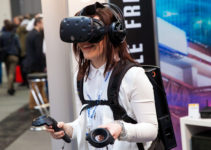IN A HURRY? CHECK OUT HTC Vive TOP PROS:
- HTC Vive offers the best overall VR experience
- Supports Steam VR
Virtual Reality has always captured the minds and dreams of almost everyone. Who wouldn’t like to immerse themselves in a virtual world where the only limit is your imagination. Even though VR technology development began in 1970s, we didn’t have any consumer products back then. There were some attempts by Apple with their QuickTime VR and by Nintendo with their VirtualBoy console, however, there weren’t any products that were more than just a gimmick. Luckily, with the announcement of the Oculus Rift back in 2010, this technology has been growing in popularity. Today we’re going to talk about the Best VR headsets on the market, and how to pick the right one for you.
In this post, we’re going to give you a comprehensive rundown of the best VR headsets are there, and what to look out for before purchasing one, VR games you should try out and how we chose those products.
In the 20th century, the term “virtual reality” referred to a broad spectrum of things, everything from a video game simulation to a 3D model on a computer monitor. Since then, and with the introduction of the aforementioned Oculus Rift, things have gotten a lot less complicated. Today, the term VR is exclusively used for things we can see inside a VR headset. However, this implies that all VR headsets are created equal, which cannot be further from the truth. A cardboard headset won’t have the same feature-set as a high-end tethered VR headset.
CONTENTS:
- Before you buy: everything you should know about VR headsets
- Best VR headsets
- VR games you have to try out
- How we choose these products
| IMAGE | PRODUCT | DETAILS | |
|---|---|---|---|
 |
Our #1 Choice
HTC Vive |
|
Check on Amazon |
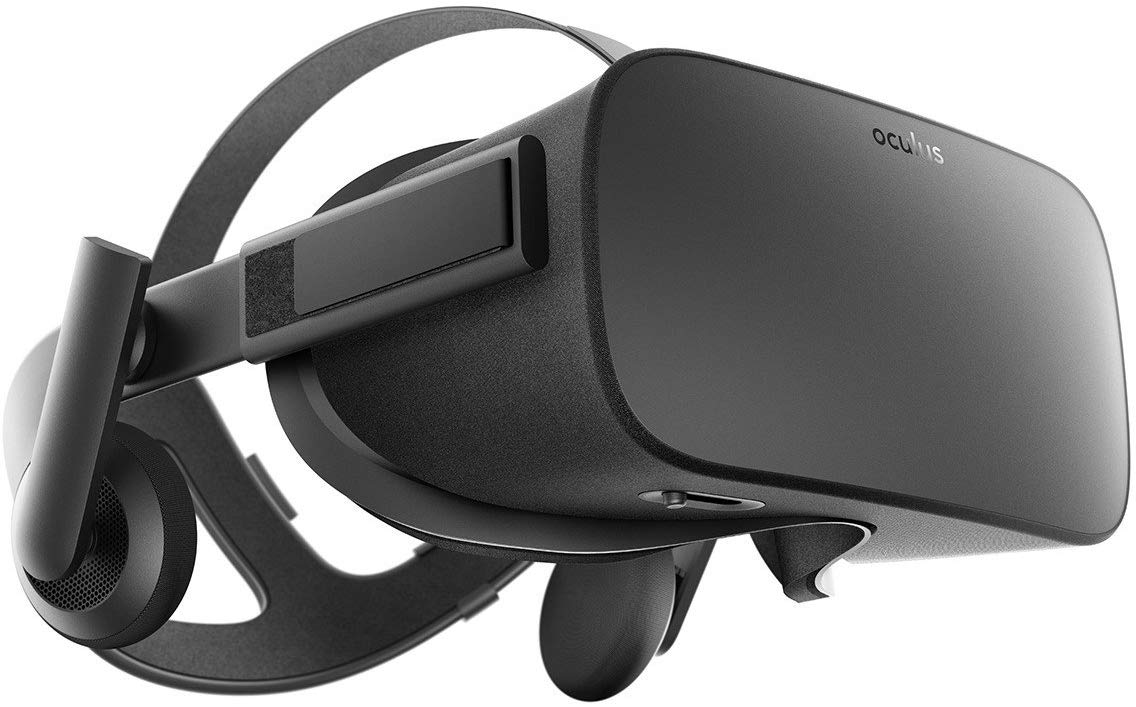 |
Oculus Rift |
|
Check on Amazon |
 |
Samsung Gear VR |
|
Check on Amazon |
 |
PlayStation VR |
|
Check on Amazon |
 |
Google Daydream View |
|
Check on Amazon |
Before you Buy: Everything You Should Know About VR Headsets
VR is an excellent way to experience new worlds from the comfort of your home. Modern VR headsets utilize motion tracking and special controllers that allow you to look around virtual space and manipulate it as if you’re really there.
When it comes to the types of VR headsets, we can organize them into two categories:
Mobile VR headsets – which are basically smartphone placeholders with special lenses. These lenses separate the screen and stretch the image so it fills your entire view.
Tethered VR headsets – are standalone devices that require a connection to your PC or console. They are a bit more cumbersome than the mobile VR headsets, but thanks to the dedicated display and external camera trackers, the experience is much more engaging.
Both tethered and mobile VR headsets come in many different models, each with its pros and cons. There is no one specific model that is right for everyone. So before setting out and picking up a headset; you should consider what type of headset you should go for, do you have the necessary hardware to run it, what’s your budget, and the ergonomics.
Type
Tethered VR headsets, such as the Oculus Rift and the Vive, require a connection to a PC or a console. This type of headsets can cost up to eight hundred dollars because they feature custom displays, motion sensors, and lenses. Not only that, but you also have to own a decent gaming rig to ensure your VR experience won’t be spoiled by hiccups and low frame rate. Tethered VR headsets are mostly intended for gaming.
Mobile VR headsets like Google Cardboard are placeholders for your smartphone. Because the most important part of any headset are the lenses, they are very lightweight and quite cheap. Most of these VR headsets are priced under one hundred dollars. The only advantage they have over the tethered headsets is that there are no cables sticking out of them.
If you are a gaming enthusiast and have a big budget, then we fully recommend you opt in for a tethered VR headset. It will offer you the richest, most immersive, jaw-dropping experience.
However, if you aren’t an avid gamer and you just want to watch videos on a huge screen, or watch panoramic photos and videos, then a mobile VR headset is a right choice for you. Thankfully both the smartphone technology and the headsets are getting improved on an almost monthly basis, which means trading up to a better model won’t break your budget.
Hardware
After you’ve figured out what type of VR headset you’re going to buy, you have to check if your hardware can handle it. This is pretty easy to do, the newer and more high-end your PC or smartphone, the better. Oculus Rift compatible PCs are priced from one thousand dollars and up. The HTC Vive has identical hardware requirements as the Rift, with the only difference being that the Vive requires only 4 gigabytes of RAM and one USB 2.0 port instead of two 3.0 ports.
When it comes to mobile VR headsets, models produced by Samsung work only with Samsung phones. This fairly limits your options, however, it ensures your VR experience won’t suffer from bugs and hiccups.
The most flexible mobile VR headset is the Google Cardboard. They are compatible with almost all iPhone models, Android phones and even Windows phones. The only thing you should pay attention to is the screen size. You must check if your phones fits the range of supported screen sizes. Your phone also has to feature a motion sensor, otherwise you won’t be able to use it with a mobile VR headset.
Price
If you are planning on buying a tethered VR headset, you better be prepared to pay a pretty penny. In addition to the cost of a VR ready PC or a PlayStation 4, you can expect to pay around eight hundred bucks for a Vive, and half that price for an Oculus Rift. The cheapest option is the PlayStation VR which can be found for around three hundred bucks.
If you’re looking for a mobile VR headset, your options are much wider. Most headsets of this type cost less than one hundred dollars, with cardboard headsets selling for as low as ten bucks.
Field of View
The field of view (or just FOV) represents the size of the image you see when you put on the VR headset. If the field of is narrow you will feel as though you’re looking through a diving mask. You have to make sure that the model you’re interested in offers a wide FOV because it will let you immerse yourself more into the environment.
When it comes to tethered VR headsets, both the Rift and the Vive feature a field of view of 110 degrees. This is only 4 degrees less than the central vision in humans, which means you won’t have trouble with perceiving depth.
As for the mobile VR headsets, the models produced by Samsung offer a field of view of 96 degrees, while the Daydream View offers only 90 degrees. Google Cardboard offers the widest range of FOV, ranging from 90 and 120 degrees depending on the model.
If you are looking for a mobile VR headset that will allow you to watch movies on private big screens, you don’t have to opt-in for an expensive model from Samsung. Some affordable headsets made in China are specifically designed for watching movies on budget-friendly smartphones.
However, if you are planning on using the headset for gaming, we advise you to go for a model that offers at least 90 degrees of FOV.
Weight
When it comes to any type of headgear, you’d want it to be as lightweight as possible. Otherwise, it will get really tiring if you use it for more than half an hour.
The weight isn’t the only factor that plays a big role in ergonomics. You also have to pay attention to the shape of the VR headset and the straps. Some of the heavier models distribute their weight so that they don’t feel so heavy, while other models have their entire weight centered in the front. This means that after a while you’ll start to feel sharp pain around your nose, which isn’t good at all. You also have to factor in the size of your head because something that might fit your friend perfectly might be extremely uncomfortable for you.
If you gathered from this that you should look for a lightweight model, you are very wrong. Lightweight headsets come with their own set of problems. Cardboard headsets and foldable headsets that clip to your phone are extremely lightweight, but you have to hold them up in front of your face because they are far too flimsy to be able to have straps attached.
Mobile VR headsets are lighter than tethered ones. For example, Samsung Gear VR weighs around 12 ounces while the Vive weigh an outstanding 20 ounces. However, you have to factor in the weight of your smartphone. A Samsung Gear VR with a phone inside it weighs around 17 ounces which is close to tethered models.
To sum it all up, pay attention to how the weight is distributed on the headset. Don’t opt in for headsets that are very top-heavy, also don’t expect from an ultra-lightweight headset to adhere to your head perfectly.
Google Cardboard QR code
Google Cardboard is one of the best selling VR headsets, not only that but there are many third-party headsets that take advantage of the Google Cardboard QR code.
So, what is this QR code we are talking about? A Google Cardboard QR code gives your phone necessary information about the headset, such as how curved and how far apart are the lenses. If you don’t scan this QR code before putting on the headset, the image will be distorted which practically guarantees you’ll get motion sick.
Unfortunately, some manufacturers, due to licensing reasons and bad product management, force you to use their proprietary apps. Before buying a mobile headset, we recommend you check if it features a Google Cardboard QR code.
The QR code looks like any standard code, expect it features an outline of a VR headset in the middle. If the headset features a Google Cardboard QR Code, you will be able to watch Youtube videos in VR, and play hundreds of thousands of games available in the Play store.
Wearing a Headset with eyeglasses
If you’re wearing glasses, not being able to use them with your VR headset can be a potential deal-breaker. Thankfully, almost all tethered VR headsets such as Oculus, Vive, and PlayStation VR can be worn with eyeglasses. However, this all depends on the size of your head and the model of your eyeglasses. Samsung’s Gear VR is also very comfortable to wear with eyeglasses.
When it comes to Google Cardboard headsets, it all depends on the model. For example, the Mattel View-Master has a really narrow view port, but the Baofeng Maing 3 features a wide viewport that can accommodate even the biggest of eyeglass models.
If you don’t suffer from serious vision impediments, then you can try and adjust the lenses. That is if the headset supports lens adjustment. Because of this we recommend you check the reviews and see if a particular model has enough room for eyeglasses, or if it allows for adjusting of the lenses.
Augmented Reality Ready
While virtual reality whisks you to a totally different world, augmented reality (AR) adds stuff on top of the world around you. This is accomplished by having a camera on the outside of the VR headset – or, when it comes to mobile VR headsets, allowing the phone’s camera to look out.
If you opt-in for a high-end VR headset, you will need to buy special add-ons that will allow you to experience augmented reality. When it comes to mobile VR headsets, almost all Google Cardboard headsets support AR, All you need is an outside cove that lets the smartphone’s camera to see out.
Some headsets come with proprietary AR apps like the View-Master VR. This particular VR headset features a translucent cover in order to allow your smartphone camera to work. Other, more budget-friendly models don’t feature fancy covers, but instead, feature a cut-out window that allows the camera to see out.
Controllers
When it comes to controls, the current reigning champion is the HTC Vive. It features external sensors that you have to put around the room and motion-sensitive controllers. The Vive allows you to walk around the VR environment and interact with it.
Vive’s biggest competition is the Oculus Rift that features two hand-held motion controllers. Unlike the Vive, you can’t move around VR environments like you would while wearing the Vive. The PlayStation VR headset is similar to the Oculus Rift because it’s designed for games that don’t require you to move around, but sit in the comfort of your couch or bed.
Mobile VR headsets like Oculus Go and Daydream View use a single motion controller. Unfortunately, these controllers don’t register body movement. This doesn’t mean they’re bad, it means you’re just a bit more limited than the tether VR headset users.
Later this year, we’re expecting the official release of the Oculus Quest, the first all in one gaming VR headset. The most exciting thing about this product is its controllers. What makes them special is that they feature something called inside tracking. Inside tracking allows you to walk around the room without having to mount external cameras, like the HTC Vive and Oculus Rift currently require.
When it comes to budget-friendly Google Cardboard headsets, you shouldn’t expect a lot from them when it comes to controls. This platform supports only one button. Some headsets feature a built-in button, some come with remote controllers (that are only compatible with Android phones), while some headsets that feature an open-sided design let you touch the screen which has the same effect as pressing a button.
Because of this, we advise iPhone users to look for a headset that features a built-in button or allow you to touch the screen because you won’t be able to use a controller.
Thankfully, most mobile VR compatible apps don’t require a controller at all. Games developed for this type of VR are mostly passive experiences where you just have to sit back and relax. Some apps that have some type of interactivity will require you to look at a particular spot until an action is performed, or you’ll have to bob your head to trigger an action.
Should you buy a VR headset?
So, should you buy a VR headset? Only you can answer this question. They are incredibly fun and they can enhance the way you play games, share photos and expand on how you experience the world around you.
Recently, teachers tapped into VR with educational apps, and people are using the VR option in Google Maps more and more, so that they can research the locations they’re planning on traveling to. VR has a ton more uses, that you’ve certainly heard of.
In the coming years, most people will have some experience with virtual reality. So if you want to try out the technology, we hope the important factors we listed above are of great help to you.
Best VR Headsets
Now that you’re familiar with all the factors you should consider before buying a VR headset, you can check out our list of the best models on the market. We hope it will help you make the best decision.
So, without further ado, let’s jump right into it.
1. HTC Vive
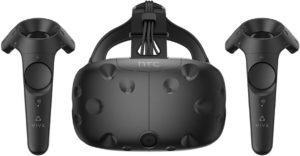
When it got released back in April of 2016, the HTC Vive was light years ahead of its nearest competitor, that being Oculus Rift. Vive supports room-scale tracking out of the box and also came with two motion controllers that allowed users to fully immerse themselves in virtual reality worlds.
Fast forward to present, and the gap has significantly narrowed. The latest Rift has the same feature-set as the Vive. However, the Vive still maintains an edge over the Oculus thanks to the superb room-scale tracking. This feature allows you to walk around a space that’s 4.5 by 4.5 meters big, giving you a whole new level of immersion. Thanks to this feature, you’re not affecting the virtual reality world with the motion controllers, you are also affecting it by using your legs to walk around it.
When it comes to the visual fidelity, the HTC Vive features two 1080p displays which makes for a very crisp image. Unfortunately, because the displays are only 1080p, you will still be able to notice individual pixels when you’re using it. The HTC Vive pro fixes this issue thanks to its 78 percent increase in dots per inch, but its price tag puts it out of range from most consumers.
When it comes to ergonomics, we have nothing that words of praise. We’ve been playing around with this headset for a better part of the month, playing games like Beat Saber and Space Pirates, and we didn’t have any issues with necks strain or the feeling the weight is concentrated on the nose. The Vive features adjustable Velcro straps and soft padding for the interior faceplate. The straps allow for the headset to adhere to your face perfectly and thanks to the interior padding you won’t feel the weight of the headset. The Vive offers ample room for glasses, but with some added discomfort.
Pros
- HTC Vive offers the best overall VR experience
- Supports Steam VR
Cons
- Requires a competent gaming PC
Bottom Line
Even though Vive is more expensive than Oculus Rift, it’s an excellent choice for people who don’t have the money to purchase a Vive Pro (that has some shortcomings that don’t justify its price). It offers an excellent experience for a reasonable price.
2. Oculus Rift
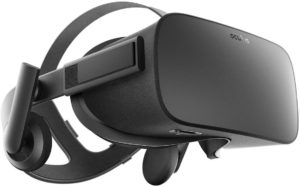
Whether you’re killing daemons in Doom VR, sneaking around with a bow and arrow in Apex Construct, or zipping around with grappling hooks in Wildlands, the Oculus Rift is chock full of super-immersive moments.
The coolest thing about this VR headset is that it doesn’t require a high-end graphics card. The Rift will work perfectly well with outdated graphics card like Nvidia GeForce GTX 1050 Ti, all thanks to the Oculus’ proprietary Asynchronous Spacewarp technology. However, if you want the best possible VR experience we advise you get a powerful gaming PC unless you already own one.
The bread and butter of this tethered VR headset is its controllers. The touch controllers are incredibly comfortable, even more than the ones you get with the HTC Vive. The positioning of the buttons and analog sticks is amazing and allows your hands to be in a relaxed fist position. Movement, such as grabbing items in the world or holding weapons, feel fluid, and most importantly, natural. If you want to further your immersion you can also buy a pair of Oculus’ attachable earphones.
When it comes to the display, the Oculus Rift has practically the same displays as the Vive. It features two 1080p OLED displays that have a refresh rate of 90 hertz. Just like with the Vive, you will be able to notice individual pixels if you pay close attention, however this stops to matter once the action gets going.
The Rift utilizes a “baseball cap” system for taking it on and off. While the Vive requires you to put the headset on your face and pull the Velcro straps over your head, Rift asks you to put it on over the back of your head and pull the headset over your eyes. The straps redistribute weight in the way you don’t feel like it’s concentrated on your nose. The interior faceplate has a soft cushion for additional comfort. Unfortunately, this VR headset is very uncomfortable to wear with a pair of glasses, so we recommend you take the glasses of and adjust the lenses if you don’t want to suffer from pain in your nose and around your eyes.
Pros
- The Oculus Rift is the one started it all
- Extremely comfortable motion-controllers
- Backed by Facebook
Cons
- Very uncomfortable to wear with glasses
- Room-scale tracking need much improvement
Bottom Line
If you don’t have enough space to accommodate for an additional sensor, and you’re looking for a competent mid-range VR headset then the Oculus Rift is an excellent choice for you. The Rift is an excellent choice for gamers because it features the best VR games around, with a catalogue of more than 20.000 games.
3. Samsung Gear VR
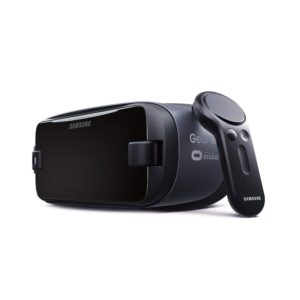
The Samsung Gear VR is one of the most popular mobile VR headsets on the market. Thankfully, this doesn’t mean that Samsung is not continuing to improve it. The latest version of this mobile VR headset adds a controller which allows for a more tactile experience that you normally don’t get with other headsets of this type.
Before we get into the rest of the review please note that this mobile VR headset is compatible only with Samsung phones. If you own one of the following phones you can consider purchasing this model: Note 4, Note 5, Galaxy S6, Galaxy S6 Edge, Galaxy S6 Edge Plus, Galaxy S7, Galaxy S8, and Galaxy S8+.
Now that we have that out of the way, we can talk about the design. To coincide with the launch of (now) last year’s Galaxy S8, the Gear VR has receive a slight cosmetic update. The headset is now available in an inky midnight blue or orchid gray. Outside the slight cosmetic change, this is your standard Gear VR headset.
This headset features a recessed touchpad on the side that allows you to control the screen while you’re wearing the headset. It also features home and back buttons above the touchpad so you can easily quit out of any apps you’re running. We appreciate Samsung’s decision to keep the swappable USB-C connector that you can switch for a traditional micro USB that older Samsung phones use.
The coolest thing about this VR headset is the controller. Samsung took a page from Google’s Daydream View’s book, and now ships the Gear VR with a one-handed controller. The controller features a circular touchpad at the top and volume buttons right below the said touchpad. The touchpad is responsive and accurate, making it easy to navigate Facebook or blast zombies. The rear trigger provided a nice snapback, as did the touchpad and the front-mounted buttons.
Pros
- Superb controller
- Features voice commands
Cons
- A bit pricey
- Exclusive to Samsung Phones
Bottom Line
By the looks of it, Samsung’s Gear VR will continue to reign in the mobile VR headset market. If you own a Samsung phone that’s compatible there should be nothing stopping you from purchasing this awesome VR headset. Thanks to the controller that this product comes with, you will have a more tactile experience than with other models on the market. Not only that, but it also features an extensive game library that you just have to try out!
4. PlayStation VR
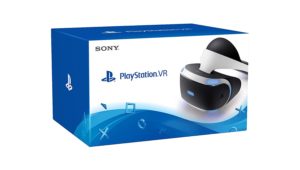
When PlayStation 4 was announced it was followed with the news that it will also come with an optional VR headset. This was fairly big news because no other gaming console has ever dabbled in this area. This VR headset is made for gaming and once you put it on, this fact becomes solidified in your mind.
Unlike other tethered VR headsets with their wires hanging everyone, PS VR is more like a companion console. All you have to do to get started is to plug it into your PlayStation 4, no hardware or software upgrades needed. Backed by an ever growing library of games such as Batman: Arkham VR and Resident Evil 7, PlayStation VR is on the straight path to becoming the king of VR market.
This VR headset has a unique design that sets is miles ahead of other headsets on the market. All thanks to the emphasis on comfort. Instead of focusing on the standard format where you have a bulky piece of plastic with a Velcro straps attached to it, the Sony PlayStation VR headset is a symphony of moving parts. The main part of the headset is, of course, the faceplate which features a central tracking light. The thick white border serves as an additional tracking light when the headset is connected to the console.
The headset uses two 5.7 inch 1080p displays that are on par with the Vive and Rift. However, because of the hardware limitations of the console itself, the graphical fidelity is not even close to either Vive or Rift. The textures are as sharp and the text is kind hard to read, but that’s a reasonable trade-off once you factor in the price and little setup is needed.
The only thing we find a bit frustrating are PS’ Move controllers. The controls aren’t as intuitive as the ones on Vive and Rift and you definitely don’t want to play in a bright room because the PS camera will have trouble picking up the wands. All VR motion-controllers require some time to get used to, and this is even more the case with the ones that ship with PS VR.
Pros
- Affordable
- Requires very little set up
- Excellent game library
Cons
- The controllers and the UI take some time to get used to
- The graphics aren’t as sharp as on the PC
Bottom Line
If you own a PS4, then we fully recommend you at least try out the PlayStation VR headset. It’s simple to set up, very comfortable to wear and is backed by a massive game library. If you want to experience the full potential of this VR headset, we recommend you play though Resident Evil 7.
5. Google Daydream View
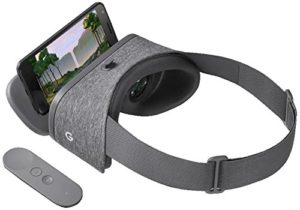
Google Daydream View features a design that definitely makes it stand out. It manufactured out of microfibers that are available in several colors. Unlike the gimmicky Google Cardboard VR viewers, this is headset more suited to Google’s reputation.
Just like with the Samsung Gear VR, the Daydream View is compatible only with Pixel phones. Namely the Pixel 2 and the Pixel 2 XL. However, Google is working on expanding compatibility so you’ll be able to use it with the latest Samsung flagships and even some less popular models like the Motorola Moto Z.
Now, let’s talk about design. This VR headset is unlike anything you’ve ever seen. It’s covered with light fabric that closely resembles yoga pants. This design choice gives this VR headset a more relatable feel that the plastic headsets offer. The headband is made out of elastic fabric that ensures the headset adheres to your face perfectly.
The field of view is almost the same as the one in Gear VR, which allows for full immersion. The biggest difference between these two is the motion blur. Motion blur occurs when you turn your head while wearing the headset. While the Gear VR had little to no motion blur, we couldn’t help but notice that even the slightest movement of your head will cause the screen to go blurry when wearing Daydream View. The visual quality also leaves a lot to be desired, but when you factor in its competitive price, it’s a reasonable trade-off.
One thing that sets both the Gear VR and Daydream View is the controller. The second you launch the Daydream on your phone, it connects to the controller via Bluetooth. The circular indentation on the top of the controller serves as a touchpad that lets you navigate the menus with motions like swiping and tapping. The home and back button below the touchpad serve both as navigation buttons and as controls while in game. The only issue we have with it is that’s a tad bit too small.
Pros
- Affordable
- Innovative design
- Comfortable to wear
- It ships with a controller
Cons
- Graphics aren’t on par with Samsung Gear VR
- No voice commands
Bottom Line
Google Daydream VR headset is an excellent choice for anyone that wants to experience VR world without having to break the bank. If nothing else, you can at least wonder at its incredible design and comfort. The included controller is intuitive and offers agile motion that will make exploring virtual worlds that more seamless.
VR Games You Have to Try Out
Now that you’ve decided what VR headset to buy, there’s still the question of what games to play. Thankfully the gaming industry is booming with new titles, and we’ve prepared this short list of must-have titles.
- Beat Saber – This game is basically like guitar hero with lightsabers. With a laser sword in each motion-controlled hand, you slash at boxes that are coming at you to a beat, ducking under low walls and dodging bombs as you go. Not only will you have fun while playing this game, but you will also get some exercise!
- In Death – A roguelike VR shooter, In Death is set in a procedurally generated medieval world of floating ruins, where forsaken souls, angelic hordes and demons alike have run amok. Battle deep into the Afterlife to restore Harmony. Engage in intense ranged combat with your weapon of choice and ever more powerful loot. Challenge other players to scale The Ladder, in asynchronous multiplayer mode. This game is available on both PC and PS4!
- Voxel Fly VR – This is a title developed for mobile VR headsets. Voxel Fly is an endless runner where you fly through an endless city while avoiding traffic and various obstacles to see how far you can go. It features leaderboards so you can compete with your friends!
- Whispering Eons #0 – Is an adventure game with some puzzle elements. You move and interact with different elements of the game world to solve puzzles, talk to NPCs, and figure out the back story. The cut scenes are quite good considering it’s a free title and the gameplay is very satisfying.
How We Choose These Products
When compiling a list of best VR headsets on the market, we were primarily focusing on the quality of the product. Even though there are countless headsets available, only a few offer a decent build quality and graphic quality. The second factor we ’re focusing on is comfort. A VR headset is only as good as it’s comfortable. And lastly, we were focusing on the price, that’s why we showcased VR headsets from all price ranges.
So what do you think about VR? Is it the future of gaming, or is it going to remain an interesting gimmick forever? Did you ever play around with any of the models showcased above? Let us know in the comments below!

